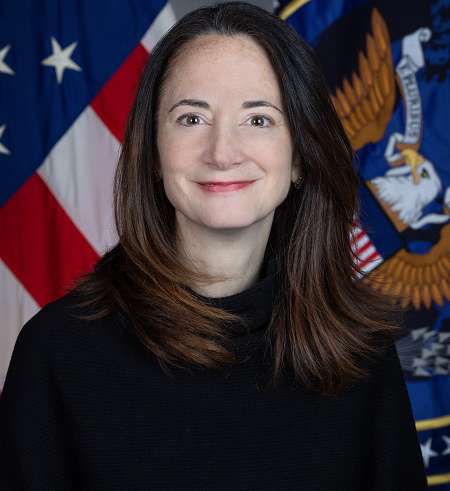By Richard Stone
The official medal to a top US spook in Canberra has provided little room for ambiguity when assessing the close working relationship between the Australian and US intelligence services. They are closely linked. Australia has, therefore, been drawn ever closer to the US through diplomatic agreements, and continues to host their sensitive military and intelligence facilities. The arrangement is fraught with dangers; US regional foreign policy and operations have included Australia in their planned military hostilities with China in the Indo-Pacific.
In late June, Avril Haines, US Director of National Intelligence, was awarded the Australian Intelligence Medal, by the Governor-General while visiting Canberra. (1) It has shown the close working relationship between the two intelligence services, which also form part of the elite Five Eyes together with the UK, Canada and New Zealand. The award ceremony was also accompanied with carefully edited media releases, which acknowledged problems arising in the Indo-Pacific region as China has emerged as a serious competitor. It included reference to ‘having integrated intelligence services is fundamental to our ultimate success … and … confirmed that the US and Australia had personnel embedded in each other’s intelligence agencies’. (2)
The finer points of the nature of the high-level diplomatic and intelligence relationship, however, remain shrouded in secrecy.
What is, nevertheless, clear is that the tentacles of the intelligence services reach into areas of civil society ‘in addition to its more traditional focus on military threats and terrorism’. (3)
Areas of increased interest included a ‘broadening in scope to encompass economic, security and advanced technology’. (4) No one would appear to escape their gaze and surreptitious scrutiny. Their agendas, likewise, are never clear although carefully edited final assessments often find their way into official media releases. They should be read between the lines.
It is important to note that studies of so-called intelligence co-operation from the previous Cold War, continue to have relevance with the present one; it was marked by extensive ‘red-tagging’ and profiling of entire populations of subject countries. The labelling of suspected ‘communists, subversives, or terrorists’, was practised by security services, government officials and ‘shills’, who used agents of influence, stooges and company goons, in order to limit opposition to political parties and governments which served ‘US interests’. One 1968 military intelligence manual advocated agents should ‘infiltrate a wide array of groups, including political parties, labour unions, youth and student groups, religious organisations and publishing organisations. (5) Intelligence-gathering was the order of the day.
It, inevitably, led to extra-judicial killings and counter-insurgency programs; which was the natural outcome of a systematic pattern of recruitment operating within a culture of impunity. One US military counter-insurgency operations manual, for example, stated it was the role of Pentagon personnel to ‘advise, train and provide operational assistance for para-military forces and that … para-military personnel should be paid in proportion to the time devoted to the cause’. (6) The piece-rate wage payments did not include ethical military considerations; para-military personnel were used to enable the US military to effectively distance themselves from acts of genocide and the requirements of the Geneva Convention.
Pentagon military training manuals from the period in 1972, furthermore, reveal an almost candid approach whereby lesson provision included ‘aerial surveillance, electronic eavesdropping, interrogation, counter sabotage measures, handling of informants, break-ins and censorship’. (7) Manuals also included wholesale surveillance programs of those participating in legal political activity and mass profiling where citizens and residents were ‘put on black, grey or white lists for the purpose of identifying and prioritising adversary targets’. (8)
The out-sourcing of such military training was also commonplace; in fact, studies of the mercenary recruitment planning for Angola in the mid-1970s used a shadowy organisation code-named Security Advisory Services. Established in 1970, the so-called SAS advertised paramilitary training in line with services also offered by official military provision. (9)
The systematic repression also included the recruitment of sympathetic or compromised medical personnel to use various mind-altering drugs ‘intravenously injected’ in order to render those under interrogation more vulnerable. (10) So much for medical ethics.
Following a brief period during the 1990s when huge troves of intelligence material was declassified, it also led to commentary which concluded ‘the anything goes mentality pervaded US strategy throughout the world’. (11) And while the development of the internet has provided those in control with far more sophisticated means by which to conduct surveillance, their mind-set has remained based on similar lines to the previous Cold War.
Australia, during the previous Cold War, was and also remains a sub-imperial power; studies of Australian military training manuals from the period reveal similar marked similarities with their US counterparts. One, made fully operational during the late 1960s period, contained references to intelligence-gathering techniques which included ‘listening posts’. (12) The reference was followed immediately with another sub-section dealing with ‘Clearing Patrols’ which were essentially counter-intelligence and counter-insurgency operations. (13) References elsewhere were also given in the same series of Australian military training manuals to ‘the most effective use is made of para-military forces’, in the Civil Affairs section. (14)
The previous Cold War period in Australia and elsewhere was also marked by a paranoid vision of the ‘enemy within’ of supposed ‘communists’ and ‘fifth columnists’ who used subversive tactics which included infiltration and propaganda through ‘front organisations’ to create factions and recruit personnel. (15) Blacklisting, therefore, by the state in collusion with employers, was commonplace.
Elsewhere, in the UK, studies of civil defence provision during the previous Cold War found senior military officials had planned seizing power in an ’emergency’ with all the hallmarks of a coup. (16) During the same period the British state was alleged to have drawn up lists of activists for detention in various centres around the country. (17) The right to protest and civil liberties?
And then there is the case of the Nugan Hand Bank in Australia, which has remained subject to official denial by the US for well over forty years. The intelligence services have a lot to hide. Washing dirty linen in public places was, and is, not considered professional. Their continued denials, however, were made to look all the more ridiculous following the declassification of documents from the period which were highly incriminating. (18)
The bank was a typical front-type organisation, designed to conceal its main purpose; ‘US interests’. Its tentacles spread across the globe into similar questionable financial institutions in various trouble-spots. (19) Following its collapse, with debts of $50 million in 1980, the remaining senior partner, Michael Hand, fled Australia wearing a false beard after destroying much of the evidence surrounding the bank. He was later discovered by Australian investigators as early as 1982, although has continued to appear to operate for decades within a culture of impunity inside various intelligence operations. (20)
The final report of a subsequent Royal Commission established the Nugan Hand Bank had ‘interwoven fraud upon fraud, produced grossly false accounts and plundered clients’ funds. The report identifies to law enforcement agencies people Mr Justice Stewart thinks committed crimes. The 205 paragraphs which identify these people have been deleted from the published report’. (21) No charges against those concerned have ever been laid, or even considered. They would appear to have operated within a culture of impunity. As they do.
While the previous Cold War made way for the present one, the same tactics are being used by those who defend traditional class and state power. They merely continued to carry the baggage and recycle its practices into the present Cold War.
It is not difficult to find examples: a recent assessment from a former Home Affairs department secretary, for example, warned of a likely war in the Pacific region before the end of the decade, ‘where US and allied forces were in combat with China and possibly Russian forces’. (22) It was accompanied by a proposal for a new defence production commission ‘to boost Australian preparedness … a new mechanism was needed to mobilise the entire economy in the face of looming peril, ensuring the entire spectrum of capital, innovation, workforce and scale across the economy was brought to bear’. (23) No reference was provided about civil liberties and the rights of workers to organise in their workplaces around trade-unions against exploitation. The military-industrial complex rub their hands with glee.
There was also nothing included in the intelligence assessment about Australia’s own defence and security requirements, only what was directly linked to ‘US interests’:
We need an independent foreign policy
1. United we stand against adversaries’ hostility,
The Australian, 26 June 2024.
2. Ibid.
3. Ibid.
4. Ibid.
5. Army’s Project X had wider Audience,
The Washington Post, 6 March 1997.
6. Counter Insurgency Operations, US Army Foreign Intelligence Assistance Program,
US Army 1960, ref: 19960709 052, Section 116 and 117 – c.
7. Lost History: Project X, Drugs and Death Squads,
Robert Parry, The Consortium magazine, 31 March 1997.
8. Ibid.
9. See: The Whores of War – Mercenaries Today,
Wilfred Burchett and Derek Roebuck, (London, 1977), pp. 29-32.
10. Lost History, op.cit.
11. Ibid.
12. Australian Military Forces, Infantry Training, Volume 4, Part 2, page 135.
13. Ibid., Clearing Patrols.
14. The Division in Battle, Organisation and Tactics, Number 1, 1965, pp. 50-51.
15. See: The Unseen Foe, Australian Army Journal, Number 66, March 1963, pp. 24-33.
16. See: Region One, Black Jake Collective, (Newcastle-upon-Tyne, 1978), and,
Region One – Supplementary, (Newcastle-upon-Tyne, 1979).
17. Confidential Source, during British Miner’s Strike, 1984-85.
18. The Sydney Connection, Nugan Hand, Murray Riley and the death of Donald Mackay,
John Giggens, (Queensland, 2004), Edward Wilson and the Second CIA, pp. 71-73,
and, Instructions for the co-ordination and control of Navy’s clandestine intelligence
collection program, Department of the Navy, 7 December 1965,
declassified: 13 July 1990, with specific reference to sub-sections, a., b., d., e., f., g.,
h., and,
The spies who are out in the cold,
Inquiry magazine, CATO Institute, 23 November 1981, pp. 11-13.
19. Ibid., Chart – Nugan Hand International, pp. 64-5, and,
Air America, Christopher Robbins, (London, 1988), pp. 319-20.
20. Interest in arrest,
The Australian, 10 November 2015.
21. See: Royal Commission Report Nugan Hand,
The Canberra Times, 28 November 1985.
22. We must prepare for war now – this decade,
The Australian, 26 June 2024.
23. Ibid.








